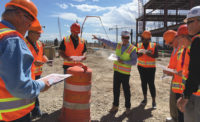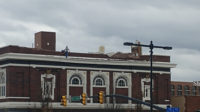Some buildings take longer to construct than others, but few people expected it would take two decades to create a new federal courthouse in Salt Lake City.
The process to upgrade or replace the city's aging Frank E. Moss Courthouse on Main Street began in the early 1990s, well before tighter security requirements for federal buildings were put into place after the Sept. 11 terrorist attacks. Not only did the old courthouse not meet new blast-proof and perimeter security standards set by Congress in 2001, it also did not allow for the separate movement of judges, prisoners and visitors within the building. In most cases, these groups were forced to share the same elevators and hallways on their way to the courtrooms. Occupancy of the building had also exceeded its design capacity. It soon became obvious that the courthouse needed to be replaced rather than upgraded.
But the story behind replacing the old courthouse isn't just about the funding starts and stops that followed the decision to build a new facility. The projected site, at 351 W. Temple, was occupied in part by the 120-year-old Odd Fellows Hall, which either had to be moved or torn down before construction could begin. After working for months with local historic preservation groups to help save the three-story building, federal authorities eventually auctioned it off to a private owner for more than $1 million in 2010, and it was moved a short distance away to a new home on Market Street. A handful of other buildings on the site, including an old gas station, were torn down to give the new courthouse its required security perimeter.
Meanwhile, design for a new building had begun as early as 1997, with security upgrades added after 2001, but Congress did not make the funds available until 2010. Initial estimates called for a $226-million building, but the owner, the General Services Administration, was initially $40 million short. However, the funding delay worked to GSA's advantage, allowing it to take advantage of lower construction and materials costs during the recession.
Salt Lake City's Okland Construction won the contract and broke ground for the courthouse in January 2011. Working on a 38-month schedule, the project is now 60% to 70% complete and on target for a March 2014 opening.
The courthouse will meet the expanding needs of the U.S. District Court in Utah. Primary tenants are the U.S. District Court, the U.S. Marshals Service and the U.S. Probation and Pretrial Services System. The 409,397-sq-ft facility includes seven district and three magistrate courtrooms, along with 14 chambers and office-support spaces on 10 floors above grade. The two floors below grade will contain parking and building support space.
Most of the space—157,000 sq ft—will be provided for the U.S. District Court and U.S. Probation, while 71,000 sq ft is planned for other executive branch agencies, including the U.S. Marshals Service, whose area includes secure holding facilities and offices. In addition, 101 structured parking spaces will be provided.
The new building is situated adjacent to and directly west of the existing Frank E. Moss Courthouse, to which it will connect by a tunnel.
The new building is "essentially one big cube with courtrooms at the corners," says Stephen Dayton, a director with project architect Thomas Phifer & Partners, New York City. It stretches 180 ft by 180 ft and is nearly 200 ft tall, surrounded by "a garden of grass, trees and landscaped elements" that serve as a public amenity as well as meet the security setback requirements, Dayton says.
Signature design elements include a circular glass staircase that connects the first three floors. It is suspended from the ceiling by steel rods and wrapped with a wooden screen. Dayton says the design team opted to use wood extensively in the public areas "to warm up those spaces." That will include wood paneling and white oak floors that temper the glass and aluminum characteristics of the exterior. "It's not by any means a traditional courthouse building," Dayton says. "But we did use some traditional elements, like wood, to give it a familiar feel inside."
The building also features a 10-story atrium in the center facing the elevator cores that will hold a large sculpture made from 380 tubes of optical aluminum created by renowned glass artist James Carpenter. Each of the tubes, which are suspended below the atrium's skylight, has different light-reflective qualities and is angled to change the light as the position of the sun varies from month to month throughout the year. "It will be spectacular," Dayton says.
But the team placed its design emphasis on the courtrooms—where people will spend most of their time in the building—in order to make those rooms a comfortable and light-filled experience. Every courtroom has one wall that is a combination of translucent panels and controlled daylight, Dayton says, to complement the wood paneling and soft, coffered ceilings that "create a calm, warm environment for justice ... with a sense of dignity."









Post a comment to this article
Report Abusive Comment